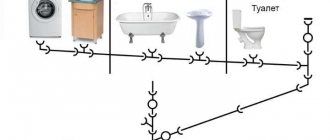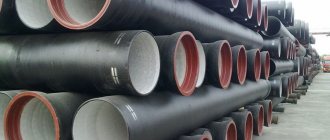Owners of private houses often have to build a sewer well with their own hands. There are many reasons for such a decision - from the need to carefully carry out excavation work to the inability to fit lifting equipment.
Often, a banal lack of money becomes an obstacle, even more so. that ready-made containers are quite expensive, not everyone can afford them. Therefore, the decision is often made to build a well yourself. This is not a very difficult task, but some skills and knowledge will be needed. It is necessary to study the standards, requirements for the installation of containers, and understand the rules for carrying out such work.
Features and advantages of concrete rings
The choice of materials for constructing containers, the main elements of an autonomous sewage system, is large: brick, metal, plastic, monolithic reinforced concrete, concrete rings.
Ordinary ceramic brick is used for these purposes if it remains in excess after construction. Its porous structure, hygroscopicity (water absorption of at least 8%) and the presence of a large number of masonry joints require comprehensive internal and external waterproofing of the tank using coating and roll materials to prevent groundwater from seeping in and wastewater from leaking out.
Metal containers can be used with a reservation - only in anaerobic septic tanks, when the flow of oxygen inside is limited by the design and principle of operation. In aerobic septic tanks in a humid, aggressive environment with forced air injection, the walls, and especially the welds, will quickly rust.
Plastic containers have virtually no disadvantages. But there are restrictions on use - they are “light”, and even when filled with wastewater, they will remain lighter than denser soil. When exposed to soil heaving forces, they can be literally squeezed out to the surface if they are not secured to a reinforced concrete slab installed as the base.
If the plastic septic tank is not secured, then heaving forces can very soon squeeze the container to the surface Source mirhat.ru
It is also advisable to strengthen the walls of the pit and provide a protective structure for the tank so that it takes loads from above.
Pouring monolithic reinforced concrete into formwork and its maturation takes a long time, significantly increasing the time from the start of construction to the commissioning of the sewerage system
Sewerage for a private house from concrete rings is built quickly, the design of the tanks has high rigidity and strength, and construction costs are low. And the reliability and durability of this material is evidenced by the fact that the main components of the central sewerage treatment facilities are made of precast reinforced concrete.
Necessary tool
Figure 3. Filtration structure
When building sewer wells with your own hands, you will need the following tools:
- Bulgarian;
- perforator;
- electric drill;
- scrap;
- sledgehammer;
- bit;
- chisel;
- shovel;
- Master OK;
- putty knife;
- hammer;
- hacksaw for metal;
- hacksaw;
- paint brush;
- construction level;
- roulette;
- plumb line;
- metal ruler.
Sewage schemes made of concrete rings
Sewerage from concrete rings is made according to different schemes. The specific type depends on the seasonality of residence, intensity of operation, financial capabilities for purchasing additional equipment and paying operating costs.
The following options can be distinguished:
- Storage septic tank. Behind this name lies an ordinary cesspool with a waterproof bottom and walls. Tightness is a mandatory requirement, failure to comply with which, according to the administrative code of the Russian Federation, is regarded as damage to the land. When the wastewater fills the container, a sewage disposal truck is called.
A storage septic tank is simply a container into which wastewater is collected Source pinterest.pt
The smaller the capacity and the higher the intensity of operation of the points connected to the sewer, the more often you need to call the car. This is often how country sewer systems are constructed from concrete rings.
Note! The term “septic tank” in this case is not used entirely correctly, since by definition it is a treatment facility with waste flowing from chamber to chamber.
- Anaerobic septic tank. Two-, less often single-chamber, septic tanks, in sealed containers of which wastewater is purified by anaerobic bacteria (without access to oxygen). The number of chambers and their volume are chosen so that at the exit of the septic tank the wastewater is purified by 65-75%. Post-treatment occurs in filtration wells (“without bottom”), trenches or fields with aerobic bacteria (it is called “biological treatment”). Only after this can wastewater be discharged into the ground. The scheme is very popular among owners of country houses and dachas due to the simplicity of the device and energy independence. The disadvantage of the scheme is that it is necessary to periodically change the sand and crushed stone in the filter structures, in which case they have to be opened and the used material must be disposed of (although this is done infrequently).
Diagram of an anaerobic septic tank made of reinforced concrete rings Source o-cemente.info
See also: Catalog of companies that specialize in water supply and sewerage.
- Aerobic septic tanks and biological treatment stations. There is also a phase of primary accumulation and partial processing of feces with the help of anaerobic bacteria. The principle of operation is the clarification of wastewater in the absence of oxygen, and additional purification in the last chamber by aerobic bacteria under conditions of forced air injection. The purity of the wastewater at the outlet is considered to be 95-98%, and it can be discharged into the ground or used for irrigation. Disadvantage: aerobic bacteria die if the air supply compressor does not work. And this happens when the network is poor due to power outages.
The operating principle of aerobic septic tanks is that electricity is required for operation. Source prostroyer.ru
Where to begin?
Of course, before starting construction, it is necessary to draw up a detailed diagram of the sewage system of a country house. Only under this condition can you avoid mistakes and not do the same work several times.
At the initial planning stage, the following activities are carried out:
- It is necessary to determine the location of the drainage well. It is better if it is a platform that is located below the level of the house.
- Now you need to determine the point where the downhill sewer pipe will exit the house.
- Next comes the stage of drawing up a diagram to scale indicating the dimensions of the pipes. In this case, you need to calculate the number of connections. The quality of the system depends on how accurate the measurements are. In addition, at this stage it becomes clear what materials and in what quantities need to be purchased.
Volumes of septic tanks, dimensions of concrete rings, bottoms and ceilings
The total volume of the septic tank is determined as the three-day water requirement at the rate of 200 liters per person. The filter well is not included in this calculation.
Note! It is believed that the cycle of separation and purification of wastewater is 72 hours.
For a single-chamber septic tank, the entire volume falls on the first chamber; for a two-chamber septic tank, the containers are usually divided in the ratio of 2/3 and 1/3. Although many “simplify” the circuit and make both containers the same, in this case the first of them must be no less than 2/3 of the calculated volume.
Knowing the volume of the septic tank, you can choose the optimal dimensions from the standard range of KS wall rings in accordance with GOST 8020-90.
Typically, sewer rings are selected from the KS15 or KS20 range.
KS7 is used as a well neck (when needed).
KS10 has a volume of 0.24 m3 with a maximum ring height of 89 cm. Three elements of the first tank of a two-chamber septic tank will only be enough for wastewater from the life of one person. They can be used in a two-chamber or three-chamber septic tank scheme as rings for the second and third tanks, if the family consists of no more than three people.
Concrete rings KS can be selected for any septic tank Source rinnipool.ru
Which material to choose
If you have decided on the choice of location, then it is worth thinking about what the well will be built from. Everything will depend on financial capabilities and availability of materials. For the construction of sewer wells the following are used:
- brick,
- reinforced concrete,
- tree,
- plastic.
In practice, it is possible to build from various materials. It is often possible to find sewer wells made of used bricks or filled with concrete. The use of reinforced concrete rings is quite common. In addition, you can see structures whose walls are made of wooden panels impregnated with a special solution against rotting. In rural areas, car or tractor tires are often used.
If you have enough funds, it is possible to buy ready-made plastic products. Such wells, made in a factory, meet all sanitary standards and can last for many decades.
Choosing a location for a septic tank, installing a filter well
The choice of location for the septic tank is carried out taking into account regulatory requirements (5 m from the house, 30-50 meters from the water intake or reservoir). The second criterion is service. Although septic tanks do not require frequent pumping like cesspools, the containers must be freed from solid sediments - otherwise they will form a large layer of “mineral” deposits at the bottom, and this will reduce the performance of the treatment system.
When biologically purifying wastewater in wells or fields, it must be taken into account that they are installed in soils with good filtering properties - sand and sandy loam.
Restrictions when installing septic tanks Source 1beton.info
For low-filtration soils, filter trenches are installed after the septic tank to collect water in storage tanks for irrigation or discharge into a nearby body of water.
If, based on the geological features of the site, a scheme with trenches and filtration fields is chosen, then it must be taken into account that only a lawn can be laid out on their area or small shrubs with a shallow root system can be planted.
Sewerage from rings Source pinterest.com
The filter well does not have a sealed bottom - instead, it is backfilled with a mixture of gravel (crushed stone) with screenings or coarse sand. The height of the backfill is about 30 cm. They no longer do it due to difficulties during subsequent replacement.
The rest of the load for filtering treated waste is taken up by the backfill around the “perforated” walls of the well. The recommended layer thickness is 30 cm. Perforation of the walls should start from the bottom and end at the level of the pipe entrance from the overflow of the last chamber of the septic tank. For the walls, either ordinary well rings are used, in the walls of which, before installation, holes with a diameter of 3-6 cm are made (with a total area of at least 10% of the total), or special perforated rings for drainage wells are installed.
Sanitary standards
When deciding whether to make the well airtight or leave a certain number of holes for wastewater outlets, it is worth familiarizing yourself with GOST standards. Sewage wells with more than 1 m3 of drainage must be sealed. Otherwise, it is necessary to equip a sufficiently high-quality cleaning system.
If the standards are not followed, the bacteria that live in the soil will not cope with water purification. Sewage will enter the soil and agricultural crops.
According to established standards, if you need to build a sealed well, it should be concreted. It also needs to be coated with a sealant. However, it is worth considering that to create a sealed well you will need to prepare a lot of consumables. It is also worth taking care of private wastewater removal.
The most popular option is to build an installation with a filter bottom. Through it the purification of impurities will be carried out.
Attention! If you decide to build a well with a septic tank, you must meet certain requirements. For example, the depth is calculated according to the soil type.
Drop, nodal and rotary type wells are completely sealed. It is also worth remembering that when draining domestic water into the sewer, you should not install a filter well. This is due to the drainage of chemicals and detergents. Repair of sewer wells after proper installation is extremely rare.
Installation features
The sewer rings are installed on the bottom slab, which acts as a slab foundation. A prefabricated reinforced concrete structure must have a stable and reliable foundation. Here you also need to prepare the bottom of the pit: leveling, compacting, backfilling with a layer of sand and crushed stone.
During installation, it is necessary to seal the seams with cement mortar, followed by treating the entire surface with waterproofing compounds.
Advice! You can choose rings “with a quarter” - profiled ends. They provide a more reliable connection in terms of joining accuracy, structural strength, and seam tightness.
The recommended height of wells is no more than three rings. If you make it higher, the structure will be “weaker”.
Stage of installation of sewerage in a private house made of concrete rings Source 1beton.info
The entrance hole to the first well is mounted no lower than 30 cm from the lid. And the overflow holes are made with a slight decrease. This leads to a decrease in the “working” volume of the septic tank, which must be taken into account when choosing ring sizes.
Types of wells
Not every dacha owner can hire a professional team of builders to install a sewer well. In addition, if you follow the instructions, no difficulties will arise during the construction process. First you should choose the type of septic tank for a private home.
There are several main types of septic tanks:
- Inspection wells located on straight sections. Such structures provide complete control of the condition of the sewerage network.
- Rotary. When installing such structures, a large number of problems associated with rotations of the communication network can be avoided. For example, leaks may appear in places where pipes bend.
- Nodal wells are installed in places of divorce.
- Drop-type installations are installed when site conditions do not allow pipes to be installed at the same level.
- Storage installations represent the end of the sewerage system. They are used to store wastewater.
Sewage systems in the country can be made in various forms. The simplest structure is a round shaft, or a rectangular installation. Such wells are quite easy to install and maintain.











